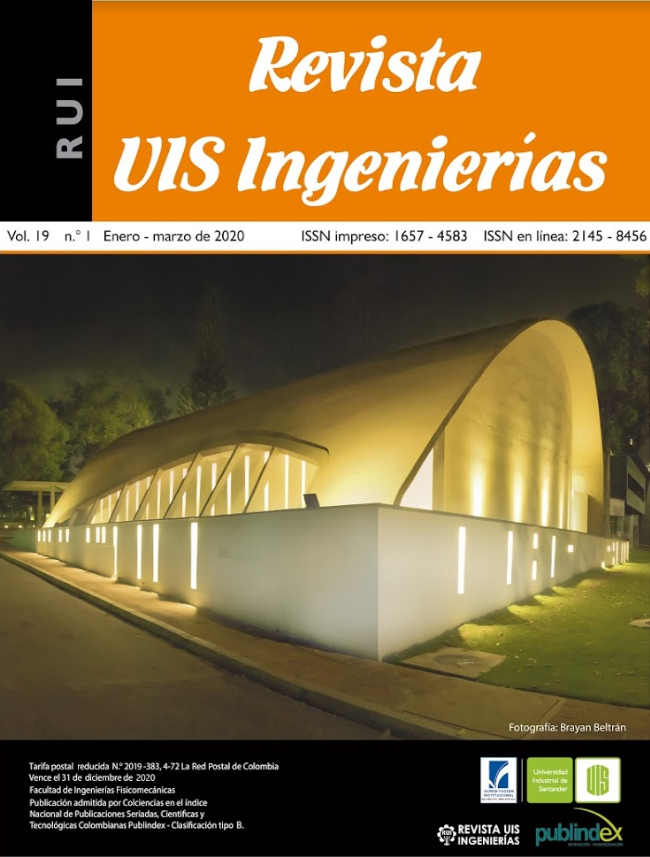Design and simulation of a pico-hydro system for the generation of electrical energy in rural areas, through a computational fluid mechanics software
Published 2020-01-30
Keywords
- Simulation,
- CFD,
- pico-hydro system,
- CFX,
- rural areas
- technical-economic analysis ...More
How to Cite
Copyright (c) 2020 Revista UIS Ingenierías

This work is licensed under a Creative Commons Attribution-NoDerivatives 4.0 International License.
Abstract
In this article is present the procedure for the design of all components of a pico-hydro system, is designed a pico hydraulic propeller turbine according to the specific condition of water potential to an estimated site of operation based on a theoretical and technical analysis. For this purpose, the main characteristics of the runner are determined for medium of statistics correlations of different designs of turbine around the world, and defining restrictions for the design such as turbine head, nominal rate flow and power required, from the data mentioned above, the value of all the variables related to the behavior of the fluid in its passage through the impeller is established and from the value of said variables and the geometry established for the impeller, the geometry is determined and the specifications of the other components of the pico-hydro system such as the spiral chamber, the suction tube, the generator and the distributor, for which two types were studied, which are a distributor of axial input of the fluid and another radial input of the fluid with respect to the axis of rotation of the turbine. For the verification of the design and expected results, a modern engineering tool is used, such as computational fluid dynamics (CFD), especially the component (CFX) to predict the flow and performance that the designed system can produce. Finally, a technical-economic analysis is carried out to study the feasibility of implementing this type of systems in a rural area.
The design of the present pico-hydro system and the contribution of computational fluid dynamics CFD, can be a viable alternative to meet the demands of electricity in a rural area that does not have this service by the supply networks responsible for this function.
Downloads
References
[2] Ávila Reita, Walter y López, Anderson, “Selección y adecuación de un sistema hídrico para el aprovechamiento energético de zonas no interconectadas - ZNI con caudales y necesidades energéticas bajas,”. trabajo de fin de grado, Universidad de la Salle, 2016.
[3] M. Barglazan y I. Bordeasu, “Contribution to hydraulic turbines draft tube design,” Mag. Hydraul. Pneum. Tribol. Ecol. Sensorics, Mechatronics, vol. Hidraulica, no. 2, pp. 32–38, 2014.
[4] C. BUSEA y S. JIANU, “Optimization of Axial Hydraulic Turbines Runner Blades Using Hydrodynamic Simulation Techniques,” 6th Int. Conf. Hydraul. Mach. Hydrodyn., Timisoara, 2004, pp. 67–72.
[5] E. L. Chica, S. C. Agudelo y N. I. Sierra, “Application of CFD to the design of the runner of a propeller turbine for small hydroelectric power plants”, Rev. Fac. Ing. Univ. Antioquia, no. 69, pp. 181-192, 2013.
[6] A. Clement, A. Brunia y H. Aven, “Estudio para el desarrollo y fabricación de generadores de baja revolución para aplicación hidráulica desarrollado y patentado por Antonio Clement,” Alianza de energía y ambiente de Centroamérica, PA 7.20 Julio, 2011.
[7] N. Cotella, P. Varela, O. Villagra, R. Kohl, “Diseño y construcción de una micro turbina hidráulica de 1kW,” Avances en Energías Renovables y Medio Ambiente, vol. 6, no.1, pp. 11-15, 2002.
[8] D. Khalifa, “Simulation of an Axial Flow Turbine Runner’s Blades Using Cfd,” Indian J. Eng. Mater. Sci., vol. 16, pp. 229–236, 2009.
[9] R. Laguna-Ruiz, “Diseño de turbina Kaplan mediante Dinámica de Fluidos Computacional,” trabajo de fin de grado, Escuela Técnica Superior de Ingeniería, 2015.
[10] F. Landa, y L. Llanganate, “Diseño y construcción de una pico central hidroeléctrica utilizando una turbina Michell Banki para la generación de energía eléctrica en el sector de Las Carmelitas del Cantón Tena,” trabajo de fin de grado, Escuela Politécnica del Ejército, 2009.
[11] C. MATAIX, Turbomáquinas hidráulicas: Turbinas en: Mecánica de Fluidos y Máquinas Hidráulicas. Madrid, España: Editorial ICAI.
[12] Y. Tobo, A. V. Ramayya, and G. Tibba, “CFD Simulation and Optimization of Very Low Head Axial Flow Turbine Runner,” International Journal of Renewable Energy Development, vol. 4, no. 3, pp. 181188, Oct. 2015. doi: 10.14710/ijred.4.3.181-188
[13] D. Novkovic, M. Lecic, J. Burazer, and D. Radenkovic, “Flow simulations in a small bulb turbine using two-equation turbulence models,” FME Trans., vol. 42, no. 2, pp. 118–127, 2014. doi: 10.5937/fmet1402118N
[14] P. Perez-Pantoja, “Grupo de Generación con turbina Kaplan Tubular,” trabajo de fin de grado, Pontificia Universidad Católica del Perú, 2007.
[15] C. Pfleiderer, Bombas Centrífugas y Turbocompresores. Barcelona, España: Editorial Labor S. A, 1960.
[16] M. Polo, Turbinas hidráulicas de reacción de flujo radial. México: Editorial Limusa. 1975.
[17] A. Rivetti, C. Lucino, J. Torres y S. Liscia, “Modelación en CFD de una turbina Kaplan y comparación con resultados experimentales,” en XXV Congreso Latinoamericano de Hidráulica, Costa Rica, 2012.
[18] A Williams, R. Simpson, “Pico hydro – Reducing technical risks for rural electrification,” Renewable Energy, vol. 34, no. 8, pp. 1986-1991, 2009. doi: 10.1016/j.renene.2008.12.011
[19] E. Sisa-Amaguaya y W. Villarroel, “Diseño e instalación de una pico central hidroeléctrica en la hacienda la Isabela,” trabajo de fin de grado, Escuela de ingeniería mecánica, 2009.

